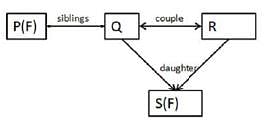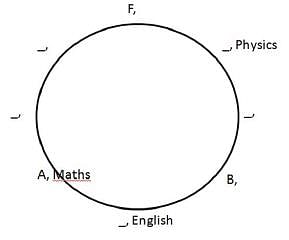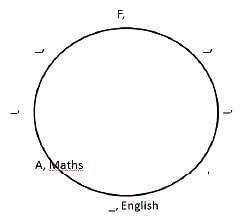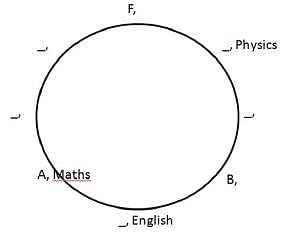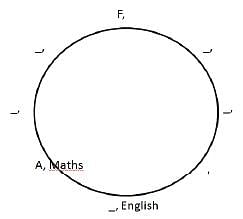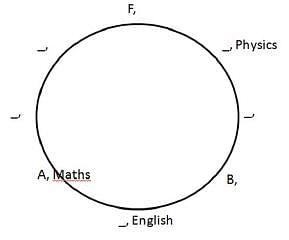UKPSC Prelims Paper 2 Mock Test - 5 - UKPSC (Uttarakhand) MCQ
30 Questions MCQ Test - UKPSC Prelims Paper 2 Mock Test - 5
Arijit and Brajesh, working together, can complete a task in 10 days, whereas Brajesh and Chandan can finish the same job in 15 days working together. If Arijit works for 5 days and Brajesh works for 8 days, it takes Chandan 9 days to complete the rest of the task. How many days will Chandan take to finish the same job alone?
Study the following information and answer the questions that follow:
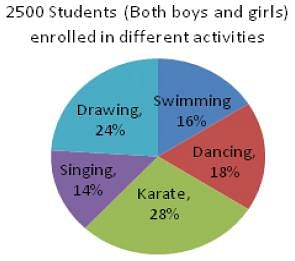
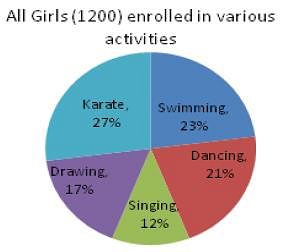
One pie chart shows the percentage distribution of the total number of students (Boys and Girls) enrolled for different activities in School A, and the other pie chart shows the percentage distribution of the total number of girls enrolled for different activities in School A.
Q. The total number of boy students enrolled in dancing and singing together is approximate what percentage of the total number of girl students enrolled for the same activities?


One pie chart shows the percentage distribution of the total number of students (Boys and Girls) enrolled for different activities in School A, and the other pie chart shows the percentage distribution of the total number of girls enrolled for different activities in School A.
| 1 Crore+ students have signed up on EduRev. Have you? Download the App |
Study the following information and answer the questions that follow:
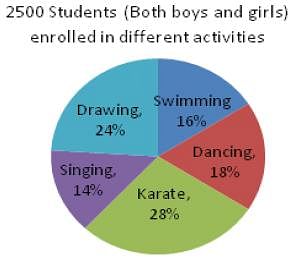
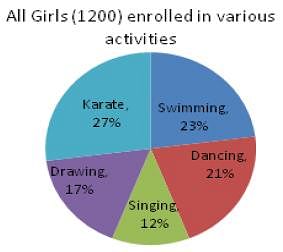
One pie chart shows the percentage distribution of the total number of students (Boys and Girls) enrolled for different activities in School A, and the other pie chart shows the percentage distribution of the total number of girls enrolled for different activities in School A.
Q. Find the ratio of the total number of boy students enrolled for dancing and swimming together to that of girl students enrolled for drawing and karate together.


One pie chart shows the percentage distribution of the total number of students (Boys and Girls) enrolled for different activities in School A, and the other pie chart shows the percentage distribution of the total number of girls enrolled for different activities in School A.
Study the following information and answer the questions that follow:
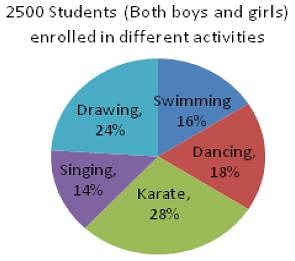
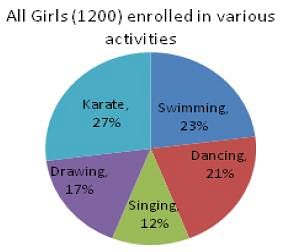
One pie chart shows the percentage distribution of the total number of students (Boys and Girls) enrolled for different activities in School A, and the other pie chart shows the percentage distribution of the total number of girls enrolled for different activities in School A.
Q. The total number of students enrolled in singing and swimming together is approximate what percentage more/less than the total number of girl students enrolled for dancing, drawing and karate together?
Read the information given below carefully and answer the following question.
Technological progress continues to accelerate and at some point, the technology of “mind uploading” becomes possible. Some human individuals upload and make many copies of themselves. Meanwhile, there is gradual progress in neuroscience and artificial intelligence, and eventually it becomes possible to isolate individual cognitive modules and connect them up to modules from other uploaded minds. Possibly, modules would need to be trained before they can communicate with each other effectively. Modules that conform to a common standard would be better able to communicate and cooperate with other modules and would therefore be economically more productive, creating a pressure for standardization. There might be multiple standards; some modules might specialize in translating between incompatible standards. Competitive uploads begin outsourcing increasing portions of their functionality: “Why do I need to know arithmetic when I can buy time on Arithmetic-Modules Inc. whenever I need to do my accounts? Why do I need to be good with language when I can hire a professional language module to articulate my thoughts? Why do I need to bother with making decisions about my personal life when there are certified executive-modules that can scan my goal structure and manage my assets so as best to fulfill my goals?” Some uploads might prefer to retain most of their functionality and handle tasks themselves that could be more efficiently done by others. They would be like hobbyists who enjoy growing their own vegetables or knitting their own cardigans; but they would be less efficient than some other uploads, and they would consequently be outcompeted over time.
Q. Which of the following is important for making copies of humans?
Read the information given below carefully and answer the following question.
Technological progress continues to accelerate and at some point, the technology of “mind uploading” becomes possible. Some human individuals upload and make many copies of themselves. Meanwhile, there is gradual progress in neuroscience and artificial intelligence, and eventually it becomes possible to isolate individual cognitive modules and connect them up to modules from other uploaded minds. Possibly, modules would need to be trained before they can communicate with each other effectively. Modules that conform to a common standard would be better able to communicate and cooperate with other modules and would therefore be economically more productive, creating a pressure for standardization. There might be multiple standards; some modules might specialize in translating between incompatible standards. Competitive uploads begin outsourcing increasing portions of their functionality: “Why do I need to know arithmetic when I can buy time on Arithmetic-Modules Inc. whenever I need to do my accounts? Why do I need to be good with language when I can hire a professional language module to articulate my thoughts? Why do I need to bother with making decisions about my personal life when there are certified executive-modules that can scan my goal structure and manage my assets so as best to fulfill my goals?” Some uploads might prefer to retain most of their functionality and handle tasks themselves that could be more efficiently done by others. They would be like hobbyists who enjoy growing their own vegetables or knitting their own cardigans; but they would be less efficient than some other uploads, and they would consequently be outcompeted over time.
Q. According to author, what are the advantages of mind uploading?
1. It helps humans to be more economically productive.
2. Same type of persons lives in a community that will decrease the conflict of Interests.
3. Every human will have same capability.
P is Q’s sister. Q is married to R. S is the daughter of Q and R. How is S related to P?
In a certain coding language, HENCE is coded as FGLEC. What shall THERE be in that code?
If a man cycles at 10 kmph, he arrives at his office at 1 PM. If he cycles at 15 kmph he will arrive at his office at 11 AM. At what speed must he cycle to get to the office at noon?
Anjali is as much younger to Vijaya as Tanya is younger to Anjali. If the sum of the ages of Vijaya and Tanya is 48, how old is Anjali?
Biodiversity is the living fabric of our planet. It underpins human well-being in the present and in the future, and its rapid decline threatens nature and people alike. According to reports released in 2018 by the Intergovernmental Science-Policy Platform on Biodiversity and Ecosystem Services (IPBES), the main global drivers of biodiversity loss are climate change, invasive species, over-exploitation of natural resources, pollution and urbanization .Biodiversity loss implies the reduction and disappearance of species and genetic diversity and the degradation of ecosystems. It jeopardizes nature‘s vital contributions to humanity, endangering economies, livelihoods, food security, cultural diversity and quality of life, and constitutes a major threat to global peace and security. Biodiversity loss also disproportionally affects the most vulnerable exacerbating inequality .To halt or reverse this decline it is vital to transform people‘s roles, actions and relationships with biodiversity. This transformation has already begun with the commitment of the international community to the 17 Sustainable Development Goals (SDGs) of Agenda 2030. This global and holistic framework highlights the complex interconnections and interdependencies between society, biodiversity and sustainable development. It recognizes that human behaviour, values and choices shape people‘s interactions with biodiversity, all of which have a direct impact on our collective future on the planet. Awareness and appreciation of the diverse values of biodiversity need to be further amplified and mainstreamed within this global framework in order to transform human behaviour in favour of biodiversity conservation and its sustainable use. Many solutions exist for stopping and reversing the decline in biodiversity. UNESCO‘s diverse networks, programmes and partners have observed positive and inspiring seeds of change around the world. UNESCO also accompanies Member States and their people in their efforts to halt biodiversity loss by understanding, appreciating, safeguarding and using biodiversity sustainably. This publication highlights some of UNESCO‘s biodiversity-related actions and solutions, based on the Organization‘s unique mandate and its diverse normative instruments, networks, programmes and partners. These actions have reduced biodiversity loss and improved the lives of many people around the planet. For each thematic challenge, the publication highlights current actions and solutions that have been successfully implemented, as well as suggestions for improvement and innovation.
Q. Regarding biodiversity which of the following is correct?
1. Biodiversity loss has minimal effect on the well-being of humans.
2. Climate change results in the reduction and disappearance of species. Select the correct answer using the code given below
Biodiversity is the living fabric of our planet. It underpins human well-being in the present and in the future, and its rapid decline threatens nature and people alike. According to reports released in 2018 by the Intergovernmental Science-Policy Platform on Biodiversity and Ecosystem Services (IPBES), the main global drivers of biodiversity loss are climate change, invasive species, over-exploitation of natural resources, pollution and urbanization .Biodiversity loss implies the reduction and disappearance of species and genetic diversity and the degradation of ecosystems. It jeopardizes nature‘s vital contributions to humanity, endangering economies, livelihoods, food security, cultural diversity and quality of life, and constitutes a major threat to global peace and security. Biodiversity loss also disproportionally affects the most vulnerable exacerbating inequality .To halt or reverse this decline it is vital to transform people‘s roles, actions and relationships with biodiversity. This transformation has already begun with the commitment of the international community to the 17 Sustainable Development Goals (SDGs) of Agenda 2030. This global and holistic framework highlights the complex interconnections and interdependencies between society, biodiversity and sustainable development. It recognizes that human behaviour, values and choices shape people‘s interactions with biodiversity, all of which have a direct impact on our collective future on the planet. Awareness and appreciation of the diverse values of biodiversity need to be further amplified and mainstreamed within this global framework in order to transform human behaviour in favour of biodiversity conservation and its sustainable use. Many solutions exist for stopping and reversing the decline in biodiversity. UNESCO‘s diverse networks, programmes and partners have observed positive and inspiring seeds of change around the world. UNESCO also accompanies Member States and their people in their efforts to halt biodiversity loss by understanding, appreciating, safeguarding and using biodiversity sustainably. This publication highlights some of UNESCO‘s biodiversity-related actions and solutions, based on the Organization‘s unique mandate and its diverse normative instruments, networks, programmes and partners. These actions have reduced biodiversity loss and improved the lives of many people around the planet. For each thematic challenge, the publication highlights current actions and solutions that have been successfully implemented, as well as suggestions for improvement and innovation.
Q. Which of the following statements is incorrect?
Read the information given below carefully and answer the following question.
Cybercrime is an evolving form of transnational crime. The complex nature of the crime as one that takes place in the border-less realm of cyberspace is compounded by the increasing involvement of organized crime groups. Perpetrators of cybercrime and their victims can be located in different regions, and its effects can ripple through societies around the world, highlighting the need to mount an urgent, dynamic and international response.
Q. Which among the following is the most logical and rational inference that can be made from the above passage?
There are three classes A, B and C with a certain number of students in each of them.In a given test, the performance of the students of various classes is measured. It is found that the average mark of Class A students is 80. The average mark of Class B students is 71. The average mark of Class C students is 82. If the average mark of Class A and B students combined is 75, and the average mark of Class B and C students is 77, then the average mark of the three classes is?
Read the information given below carefully and answer the following question.
Collective bargaining is a key means through which employers and their organizations and trade unions can establish fair wages and working conditions. It also provides the basis for sound labour relations. Typical issues on the bargaining agenda include wages, working time, training, occupational health and safety and equal treatment. The objective of these negotiations is to arrive at a collective agreement that regulates terms and conditions of employment. Collective agreements may also address the rights and responsibilities of the parties thus ensuring harmonious and productive industries and workplaces.
Q. Which among the following is the most logical and rational inference that can be made from the above passage?
Read the information given below carefully and answer the following question.
Much has been said and written about what foreign direct investment (FDI) in retail can do. Depending on which side of the ideological divide is speaking, the assertions are either that it is a magic wand to fix many big problems or that it is a destroyer of honest livelihoods, with little benefits of its own. What is common to both sides is that they are mostly low on fact, high on opinion and generate enormous amounts of confusion. Which is why, I think it is necessary to sift through all of the nose and look truth in the eye. The facts, as I see it, tell us that it has become a symbolic issue, far beyond what reality demands it ought to be; and that there is no need for either great celebration or for deep despair over the idea that FDI in retail is now a reality. My analysis tells a fairly straightforward story.
The government has hugely exaggerated the quantum and immediacy of benefits it put on the table to sell the policy-that common man will benefit enormously, employment generation will be huge, the country’s supply chain will be transformed and large numbers of small producers and farmers will gain. As things stand, even if modern retail were to take off on all cylinders, these arguments would still not hold water for the next 10 years.
For one, there is the fact that aside from very old markets like America and Europe, in most newly developed markets, modern trade accounts for only 20-25 percent of all retail. India is already at 8 percent-which is significant – but the impact hasn’t been as dramatic as one would have assumed.
Then there is the fact that the economics of the Indian market is such that it makes little sense for global retailers to focus on all consumers. I am convinced they will focus their energies on the top 33 percent of urban Indian households (a mere 10 percent of all Indian households); investing in the others isn’t quite what they know how to do profitably yet.
As for small manufactures, I don’t see that huge numbers of them will benefit. Retailers across the world like to work with a small group of select vendors because it makes for better profitability. So yes, a small number will benefit significantly. And yes, employment will be generated. But it won’t be anywhere close to the numbers now being touted.
Then there is the argument that encouraging modern retail to invest will provide the much-needed booster shot for the country’s dismal supply chain infrastructure. Here again, let’s face it. Retailers aren’t in the business of building national infrastructure. About the only infrastructure they’d be interested in is their last mile.
The only argument that holds true is that kiranas or the small, traditional shopkeepers who are now an Indian staple, will not die. But that is a tribute to the small shopkeeper rather than prescience on the part of the government.
Q. According to the author, which of the following is not a common attribute of the arguments put forth by the pro-and anti FDI ideologues?
1. Likely to be false.
2. Judgmental.
3. Positive about FDI in retail.
4. Strongly opposed to FDI in retail.
Read the information given below carefully and answer the following question.
Much has been said and written about what foreign direct investment (FDI) in retail can do. Depending on which side of the ideological divide is speaking, the assertions are either that it is a magic wand to fix many big problems or that it is a destroyer of honest livelihoods, with little benefits of its own. What is common to both sides is that they are mostly low on fact, high on opinion and generate enormous amounts of confusion. Which is why, I think it is necessary to sift through all of the nose and look truth in the eye. The facts, as I see it, tell us that it has become a symbolic issue, far beyond what reality demands it ought to be; and that there is no need for either great celebration or for deep despair over the idea that FDI in retail is now a reality. My analysis tells a fairly straightforward story.
The government has hugely exaggerated the quantum and immediacy of benefits it put on the table to sell the policy-that common man will benefit enormously, employment generation will be huge, the country’s supply chain will be transformed and large numbers of small producers and farmers will gain. As things stand, even if modern retail were to take off on all cylinders, these arguments would still not hold water for the next 10 years.
For one, there is the fact that aside from very old markets like America and Europe, in most newly developed markets, modern trade accounts for only 20-25 percent of all retail. India is already at 8 percent-which is significant – but the impact hasn’t been as dramatic as one would have assumed.
Then there is the fact that the economics of the Indian market is such that it makes little sense for global retailers to focus on all consumers. I am convinced they will focus their energies on the top 33 percent of urban Indian households (a mere 10 percent of all Indian households); investing in the others isn’t quite what they know how to do profitably yet.
As for small manufactures, I don’t see that huge numbers of them will benefit. Retailers across the world like to work with a small group of select vendors because it makes for better profitability. So yes, a small number will benefit significantly. And yes, employment will be generated. But it won’t be anywhere close to the numbers now being touted.
Then there is the argument that encouraging modern retail to invest will provide the much-needed booster shot for the country’s dismal supply chain infrastructure. Here again, let’s face it. Retailers aren’t in the business of building national infrastructure. About the only infrastructure they’d be interested in is their last mile.
The only argument that holds true is that kiranas or the small, traditional shopkeepers who are now an Indian staple, will not die. But that is a tribute to the small shopkeeper rather than prescience on the part of the government.
Q. With which of the following about the benefits of FDI in retail would the author agree?
1. The common man may not benefit greatly.
2. Employment generation may not be that huge.
3. Farmers and small producers shall be benefited greatly.
The average mark of 15 students in a CSAT test is 50. If the average mark of the first eight students is 47 and that of the last eight students is 55, then what will be the marks of the 8th student?
A tank has two pipes – A and B, attached to it. A can fill the tank in 20 minutes, whereas pipe B can empty the tank in 30 minutes. If both A and B are opened alternately for one minute each, how long will it take to fill the tank?
At a specific rate of simple interest, a sum doubles itself in 5 years. In how many years will it becomes four times itself?
Read the information given below carefully and answer the following question.
This article was written in 1978.
Recent years have brought minority-owned businesses in the United States unprecedented opportunities—as well as new and significant risks. Civil rights activists have long argued that one of the principal reasons why Blacks, Hispanics, and other minority groups have difficulty establishing themselves in business is that they lack access to the sizable orders and subcontracts that are generated by large companies. Now Congress, in apparent agreement, has required by law that businesses awarded federal contracts of more than $500,000 do their best to find minority subcontractors and record their efforts to do so on forms filed with the government. Indeed, some federal and local agencies have gone so far as to set specific percentage goals for apportioning parts of public works contracts to minority enterprises. Corporate response appears to have been substantial. According to figures collected in 1977, the total of corporate contracts with minority businesses rose from $77 million in 1972 to $1.1 billion in 1977. The projected total of corporate contracts with minority businesses for the early 1980‘s is estimated to be over 53 billion per year with no letup anticipated in the next decade. Promising as it is for minority businesses, this increased patronage poses dangers for them, too. First, minority firms risk expanding too fast and overextending themselves financially, since most are small concerns and, unlike large businesses, they often need to make substantial investments in new plants, staff, equipment, and the like in order to perform work subcontracted to them. If, thereafter, their subcontracts are for some reason reduced, such firms can face potentially crippling fixed expenses. The world of corporate purchasing can be frustrating for small entrepreneurs who get requests for elaborate formal estimates and bids. Both consume valuable time and resources, and a small company’s efforts must soon result in orders, or both the morale and the financial health of the business will suffer.
Q. According to the passage, civil rights activists maintain that one disadvantage under which minority-owned businesses have traditionally had to labour is that they have
Read the information given below carefully and answer the following question.
This article was written in 1978.
Recent years have brought minority-owned businesses in the United States unprecedented opportunities—as well as new and significant risks. Civil rights activists have long argued that one of the principal reasons why Blacks, Hispanics, and other minority groups have difficulty establishing themselves in business is that they lack access to the sizable orders and subcontracts that are generated by large companies. Now Congress, in apparent agreement, has required by law that businesses awarded federal contracts of more than $500,000 do their best to find minority subcontractors and record their efforts to do so on forms filed with the government. Indeed, some federal and local agencies have gone so far as to set specific percentage goals for apportioning parts of public works contracts to minority enterprises. Corporate response appears to have been substantial. According to figures collected in 1977, the total of corporate contracts with minority businesses rose from $77 million in 1972 to $1.1 billion in 1977. The projected total of corporate contracts with minority businesses for the early 1980‘s is estimated to be over 53 billion per year with no letup anticipated in the next decade. Promising as it is for minority businesses, this increased patronage poses dangers for them, too. First, minority firms risk expanding too fast and overextending themselves financially, since most are small concerns and, unlike large businesses, they often need to make substantial investments in new plants, staff, equipment, and the like in order to perform work subcontracted to them. If, thereafter, their subcontracts are for some reason reduced, such firms can face potentially crippling fixed expenses. The world of corporate purchasing can be frustrating for small entrepreneurs who get requests for elaborate formal estimates and bids. Both consume valuable time and resources, and a small company’s efforts must soon result in orders, or both the morale and the financial health of the business will suffer.
Q. The passage suggests that the failure of a large business to have its bids for subcontracts result quickly in orders might cause it to
Read the information given below carefully and answer the following question.
This article was written in 1978.
Recent years have brought minority-owned businesses in the United States unprecedented opportunities—as well as new and significant risks. Civil rights activists have long argued that one of the principal reasons why Blacks, Hispanics, and other minority groups have difficulty establishing themselves in business is that they lack access to the sizable orders and subcontracts that are generated by large companies. Now Congress, in apparent agreement, has required by law that businesses awarded federal contracts of more than $500,000 do their best to find minority subcontractors and record their efforts to do so on forms filed with the government. Indeed, some federal and local agencies have gone so far as to set specific percentage goals for apportioning parts of public works contracts to minority enterprises. Corporate response appears to have been substantial. According to figures collected in 1977, the total of corporate contracts with minority businesses rose from $77 million in 1972 to $1.1 billion in 1977. The projected total of corporate contracts with minority businesses for the early 1980‘s is estimated to be over 53 billion per year with no letup anticipated in the next decade. Promising as it is for minority businesses, this increased patronage poses dangers for them, too. First, minority firms risk expanding too fast and overextending themselves financially, since most are small concerns and, unlike large businesses, they often need to make substantial investments in new plants, staff, equipment, and the like in order to perform work subcontracted to them. If, thereafter, their subcontracts are for some reason reduced, such firms can face potentially crippling fixed expenses. The world of corporate purchasing can be frustrating for small entrepreneurs who get requests for elaborate formal estimates and bids. Both consume valuable time and resources, and a small company’s efforts must soon result in orders, or both the morale and the financial health of the business will suffer.
Q. The author would most likely agree with which of the following statements about corporate response to working with minority subcontractors?
Read the information given below carefully and answer the following question.
Eight professors of a college – A, B, C, D, E, F, G and H, are sitting around a circular table for a meeting. Each of them belongs to a different department – Mathematics, English, Physics, Chemistry, Biology, Hindi, History and Geography, not necessarily in the same order.
The following information is known about the professors.
1. F, who is not from Physics department, sits third to the left of the one who is from Mathematics department.
2. Two professors sit between F and A, who is from Mathematics department.
3. The professor of English department sits to the right of A.
4. The professor of Physics department sits second to the right of B, who is not an immediate neighbour of A or F.
5. Only professor C of History department sits between H and the one who is from the Biology department.
6. G belongs to Geography department and B belongs to Chemistry department.
Q. To which department does H belong?
Read the information given below carefully and answer the following question.
Eight professors of a college – A, B, C, D, E, F, G and H, are sitting around a circular table for a meeting. Each of them belongs to a different department – Mathematics, English, Physics, Chemistry, Biology, Hindi, History and Geography, not necessarily in the same order.
The following information is known about the professors.
1. F, who is not from Physics department, sits third to the left of the one who is from Mathematics department.
2. Two professors sit between F and A, who is from Mathematics department.
3. The professor of English department sits to the right of A.
4. The professor of Physics department sits second to the right of B, who is not an immediate neighbour of A or F.
5. Only professor C of History department sits between H and the one who is from the Biology department.
6. G belongs to Geography department and B belongs to Chemistry department.
Q. Who is from the English department?
Read the information given below carefully and answer the following question.
Eight professors of a college – A, B, C, D, E, F, G and H, are sitting around a circular table for a meeting. Each of them belongs to a different department – Mathematics, English, Physics, Chemistry, Biology, Hindi, History and Geography, not necessarily in the same order.
The following information is known about the professors.
1. F, who is not from Physics department, sits third to the left of the one who is from Mathematics department.
2. Two professors sit between F and A, who is from Mathematics department.
3. The professor of English department sits to the right of A.
4. The professor of Physics department sits second to the right of B, who is not an immediate neighbour of A or F.
5. Only professor C of History department sits between H and the one who is from the Biology department.
6. G belongs to Geography department and B belongs to Chemistry department.
Q. If professor G absents himself of the next meeting and the seating position of the remaining professors remains the same, the professor of which department shall be sitting to the immediate right of B in that meeting?
Direction: Study the following information carefully and answer the questions given below:
Six friends P, Q, R, S, T and U gather at P’s home to watch a one-day cricket match on TV. Each friend belongs to a different state, viz. Bihar, Goa, Haryana, Manipur, Nagaland, and Sikkim but not necessarily in the same order. Each friend has a different occupation, viz. Officer, Doctor, Teacher, Clerk, Salesman and Accountant. The one who is a Teacher belongs to Goa. The one who is a Doctor is not from Nagaland. S is a clerk, Neither R nor P is a Doctor. The one who is from Manipur is an Officer. P does not belong to Manipur. The person who belongs to Sikkim is T but is not a Doctor. Q is neither a Teacher nor a Doctor, and he is from Bihar.
Which of the following combinations is correct?
A person had to multiply two numbers. Instead of multiplying by 33, the person multiplied by 51, and the product went up by 360. What is the raised product?
What should come in place of question mark in the following number series? 2 9 21 91 447?
Read the information given below carefully and answer the following question.
Financial inclusion plays a crucial role in inclusive development and sustainable prosperity as is being increasingly recognised and acknowledged globally. Large segment of population need to be part of formal payment system and financial markets. Financial inclusion would also broaden and deepen financial savings and lead to higher economic development.
Previous initiatives: While financial sector policies in India have long been driven by the objective of increasing penetration and outreach, the goal of inclusion has eluded us. About 41 per cent of adult population remain unbanked and the number of loan account covers only 14 percent of adult population. The previous initiatives included (i) the expansion of network of cooperative banks to provide credit to agriculture and saving facilities in rural areas, (ii) nationalism of bank in 1969 and expansion of branches and (iii) creation of an elaborate framework of priority sector lending with mandated targets as part of a strategy to meet the savings and credit needs of large section of the Indian population who had no access to institutional finance. Given the sheer enormity of the challenge, however the outcomes of these efforts have so far been mixed.
Recent initiatives/out of the box approaches: Recent initiative include (i) “no frill” account for retail purpose; (ii) simplified KYC (Know Your Customer) (iii) Credit counselling centre facilities; (iv) use of NGOs and formation of SHGs; (v) Kisan credit cards service and (vi) extension of smart cards. The finance Minister in his Budget Speech of 2007-08 also laid down provision for funding of financial inclusion goals. The Rangarajan Committee also spelt out priorities for meeting financial inclusion objectives. Two of the more important approaches in the recent times included the use of technology such as smart cards and mobile telephone banking. The potential for their spread can be vast especially in combination with banking correspondence approach launched recently.
New entry and competition: In addition, new competition and entry also play crucial roles, as is evident from the global experience. Two particular initiatives have included the role of Micro Financial Institutions (MFIs) and Non-Bank Finance Companies (NBFCs). MFI activities have surged in recent years, but has come under scrutiny and regulation. Services expanded at a fast rate, providing access on better terms than the alternatives of traditional money lenders. However, better regulation is also needed. On NBFCs, gold pawn establishment have also provided alternate access and are fast expanding in urban and semi-urban settings. As far as caps on interest rates are concerned, as in case of other products, ‘subsidies’ in the form of low interest are often an inhibitor of access to services because of rationing and misuse.
Financial Literacy: Any policy initiative seeking to afford greater access to financial services to financial services to a large segment of the population must necessarily address bridging the existing knowledge gap in financial education and literacy. Over the last decade or so, researcher all over the world, especially in the developed countries, have, therefore, started to study and explore whether individuals are wellequipped to make financial decisions. Financial education and literacy assumes urgency in any given scenario.
Q. Which of the following would be closest to the meaning of term financial inclusion?



